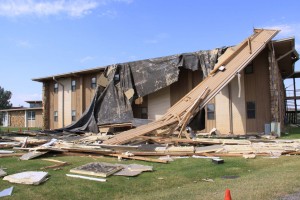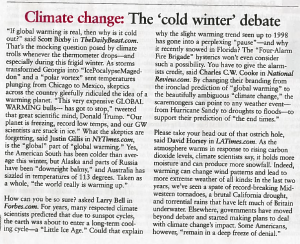This New York Time Article talks about how a group of Senators calling themselves the climate caucus are planning an all night speech session from 6:30 PM to 9 AM. They do not believe a bill will be passed this year but hope their efforts will lay groundwork for a major bill in environmentalism that would be feasible in the near future.
Month: March 2014 (Page 3 of 4)
 Here is a New York Times article on the declining moose population in Minnesota. The moose thrive in this abnormally long winter, but have the past hotter and longer summers in combination with shorter winters stressed them out? With warmer temps, the white-tailed deer population has risen which is the carrier of brain worm, which is fatal to moose. Is climate change to blame? If it is, what can we do for the Minnesota moose population. Or is this rapid recent decline similar to that of the brown bats on the East Coast…unable to be explained.
Here is a New York Times article on the declining moose population in Minnesota. The moose thrive in this abnormally long winter, but have the past hotter and longer summers in combination with shorter winters stressed them out? With warmer temps, the white-tailed deer population has risen which is the carrier of brain worm, which is fatal to moose. Is climate change to blame? If it is, what can we do for the Minnesota moose population. Or is this rapid recent decline similar to that of the brown bats on the East Coast…unable to be explained.
The Colorado River is so heavily exploited it no longer reaches the sea. Still, people are flocking to the Sunbelt states in search of a desert climate with all the conveniences of limitless tap water and green golf courses. Portions of the sunbelt also makes great farmland provided there is enough water for irrigation. Garret Hardin’s 1968 paper the “Tragedy of the Commons” describes how individuals in a group naturally tend to act according to their own self-interest. Without proper regulation, the members of the group ultimately over-exploit a limited common resource to the detriment of the whole group. Pervasive drought in the Colorado watershed is leading to a serious debate on how water will be rationed in the future.
This op-ed in the NY Times explains how drought, water, California agriculture, and increasing consumption of beef in Asia are all connected.
The link below is to an article on the NY Times website from March 5, describing record fines for Alpha Natural Resources, a coal company in the United States. The fines total $27.5 million for more than 6,000 violations they received from 2006 to 2013. The violations were related to water quality and the discharge of pollutants. The company states their new equipment will help prevent further discharge of pollutants.
I just came across this building while working on the project. It has a lot of AMAZING features that led it to receive PlATINUM Certification from LEED.
The building’s roof provide not only habitat for birds but also includes four BEE HIVES, housing 60,000 bees!!
Olympic Winter Games have damaging effect on Sochi’s environment
The Sochi Olympics, while they may have been exciting, destroyed many areas around the town, including vital wetlands and forests.
They also built houses next to the flooding river and on the mountains where they can be damaged.
Despite the protests of many ecologists and townspeople, the Russian government went ahead with its preparations.
http://in.reuters.com/article/2014/03/09/china-drone-idINDEEA2800G20140309
China, with its huge smog and pollution problem, seems to be trying alternative methods to reduce the smog rather than simple regulations such as those in the US and other countries. It recently deployed drones which release a catalyst to destroy the smog.
As nearly 95% of the state of California remains in a drought, new desalination plants are being considered.
A new 50 million gallon/day plant is on track to open Carlsbad, Ca in two years, and several other communities in the state are considering similar solutions. However, the ecological impact and the high price that are still inherent to desalination are causing many towns to hold to out for cheaper sources of water.
Russia has long been a major supplier of natural gas to Europe (Germany is its largest customer), giving it much influence in the region. But this could change in the not too distant future – see this NYtimes article
This is the statistics for the electricity generation for 2012. The majority of the sources were coal (37%) and Natural Gas (30%). Followed by Nuclear (19%). Petroleum only accounted for 1%. The remaining 12% comes from renewable energy.
Out of all renewable energy, 56% came from Hydropower, 28% came from wind power, 8% from biomass wood, 4% from biomass waste, 3% from geothermal and 1% were solar power.
Source: http://prezi.com/ic6p7nbzxddp/352-11-12/ (Prof. Nicodemus’ class Prezi for EGRS 352)
I was at the Sustainability Committee meeting as a group today (with my EGRS 480 group) and one of the topics mentioned was the Lafayette Eco-Reps Program. The goal for the program would be to save college money and reduce required labor from Plant Operations. In addition, this would be in line with an increased interest in sustainability. The program would have incentives where students can get paid as a stipend or work study, or get a class credit. Faculty and staff would consist of department eco-leaders and Green Office Certification. There would be programs within dorms and one campus-wide project a semester. For now, the initiatives includes dorm recycling, energy/water use, farmers’ market, freshman orientation connection, green move-in/out, cleanup events, sticker and logo program, and field trips.
Unfortunately, like all projects proposals, there are challenges. The challenges include funding, recruitment and the searching of an advisor. The plan for the future would be to research on other eco-rep programs and create comprehensive goals and structure. Moreover, there would be a dialogue with administration in order to secure funding and legitimacy of this program.
In regards to the earlier post about how global warming gets ridiculed during winters like this one – see this link. It turns out we just had the fourth warmest January every recorded, GLOBALLY.
Check out this cartoon:
Believe it or not, leftover animal fat can turn into soap. Specifically, this soap is made of fat from duck, water and NaOH (sodium hydroxide). To make things even more sustainable, the packaging is made of recycled paper.
When I was in late elementary school, I was addicted to simulation games. SimCoaster was one of them, and it was a simulation of an amusement park. Once I ran the park, unfortunately, a lot of people were getting sick and the park was becoming a mess. Solution? I got a tip where plants can cause a healthier environment. I then proceeded to plant trees and other plants throughout the park and especially near rides. The park became a lot healthier and cleaner.
In real life, not only that having plants nearby can keep people healthy, but also have a more attractive landscape, regardless of what type of location. The following link can provide reasons why trees are beneficial:
http://www.treepeople.org/top-22-benefits-trees
The reasons include cleaning the air, providing oxygen, and even improve people’s psychology (and therefore reducing violence).
A lot of us think of cruises as a dream vacation. Unfortunately, cruise ships cause substantial air pollution. Carnival Cruise Lines has been taking corrective action by learning a lesson from the power plant and automobile technologies. Over the next three years, Carnival had a goal of reduce SO2 and trap soot in a filter on up to 32 cruise ships. In addition, while docked in ports, the ships would no longer idle and instead be connected to an electrical grid. This will not be an easy and cheap task but at least Carnival is moving closer towards sustainability.
Source: http://www.foxnews.com/travel/2013/09/06/deal-with-epa-requires-company-to-install-power-plant-technology-on-cruise-ship/
Roof damage is a major contributor to the overall cost of storms. LEED structures often use highly efficient roofing materials and it just so happens that many of these materials, such as steel and aluminum, are resilient in storms.
http://www.environmentalleader.com/2014/03/03/green-building-takes-the-wind-out-of-strong-storms/
At one time, “global warming” was an easily digestible term used to describe the highly complex interaction between the climate and greenhouse gases. As pointed out in the article below, the weakness of “global warming” is that it oversimplifies climate change and it provides critics an easy punchline in light of the bitter winter felt by the eastern half of the country.
Check out Harvard’s sustainability website! Under the “Topics” tab, look at the Green Buildings. Since we are visiting Grossman House tomorrow, I thought I would stick to the theme of sustainable living and building. See how their projects compare to Lafayette’s, and how our schools differ.
I came across this link that shows detailed facts and statistics about recycling in the United States and the world.
http://www.cpmfg.com/2012/04/11/the-best-recycling-programs-in-the-us-around-the-world-infographic/
First, it shows the recycling rates by country (Switzerland being the best at 52%, compared with 31.5% for the United States). Followed by the top 10 greenest US/Canada cities, with San Francisco leading at 83.8% (compared with New York City at 79.2%).
The next comes the total MSW (municipal solid waste) generation in 2010 (the largest percent being paper at 28.5% of all waste).
Recycling and composting more than 80 millions tons of MSW is the equivalent of saving more than 1.3 x 10^15 BTU of energy or 229 million barrels of oil.
Lastly, it shows top ten recycling colleges in the US, and it is a shame that Lafayette is not on the list. Hope it will someday.





Recent Comments